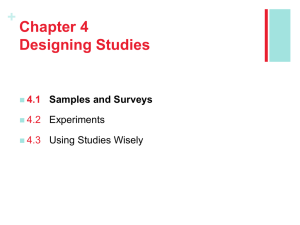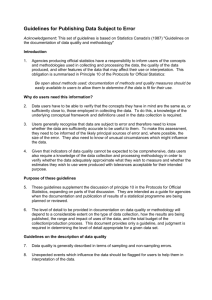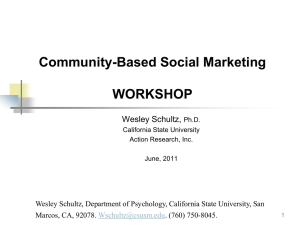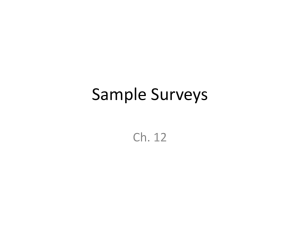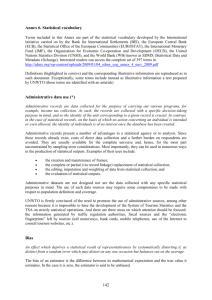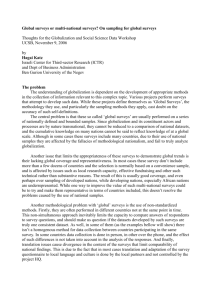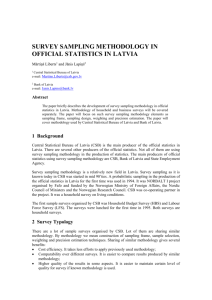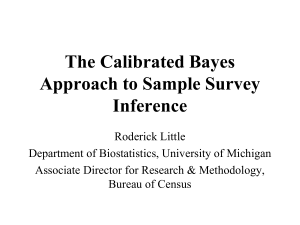Surveys - good and bad
advertisement
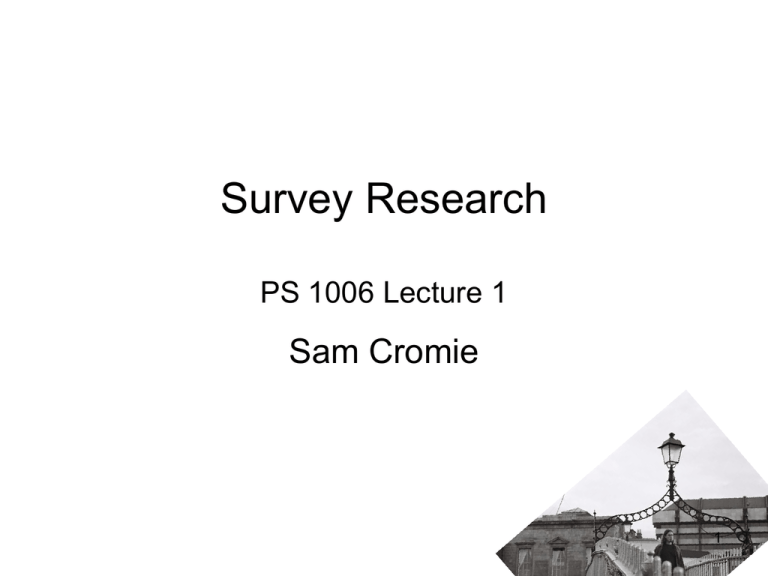
Survey Research PS 1006 Lecture 1 Sam Cromie 1 Research Methods • Observational research – Unstructured – Structured – Participatory • Experiments – Group design • Within-subject • Between subject • Surveys • Qualitative research – – – – Interviews Focus groups Document analysis Etc. • Case studies – Single-subject design 2 Survey research Sampling Methods Writing good questions Data Collection Methods Research Designs Essential Reading: Research Methods in Psychology (5th or 6th edition) Shaughnessy, Zechmeister & Zechmeister Surveys: Advantage and Disadvantages • Positives – Easy to sample a large number of people – Context likely to retains ecological validity – Relatively easy to administer • Negatives – Danger of biased surveys – People may not answer truthfully – No true IVs - Cannot infer causality Types of question • Open-ended - ‘How do you feel today?’ – Allows wide range or responses - preferable when researcher has little idea of the type or response to expect – Respondents decide how much information to give – Lack of structure can make scoring of the responses difficult 5 Types of question • Closed questions - ‘On a scale of 1-5 how happy do you feel today?’ – A fixed set of responses is provided – Respondent must pick one – Easy to score – May miss responses that some participants wants to give since the scope for answers is limited 6 Types of question • Mixed questions – A fixed set of responses is provided – An open-ended choice is given to cover any alternatives that may have been missed – Still has a limited scope How do you feel today? A. Happy B. Sad C. Angry D. Relaxed E. Other (specify)_________________________________ 7 Response scales • Categorical questions – non-directional options How are you happy today? Happy Angry Tired Sad • Likert Scales - Labeled points on scale I am Happy today Strongly Agree Agree Disagree Strongly Disagree • Percentages How happy are you on a percentage from 1-100 • Continuous scales Please mark the line below to express you level of happiness: Happy Unhappy Categorical Questions • Often used for demographic information: – Job type, ethnic background, etc. • Dichotomous questions – only two options: Yes/no, Male Female – No indication of response strength • Can be used as quasi IVs in data analysis • Can be analysed with other categorical questions using Chi Squares Likert Scales • Labeled points on scale • Several possibilities – Strongly agree, Agree, Disagree, Strongly disagree – Scale from 1-5 with ends (poles) labeled – Useful to try and define parts of the scale (anchoring) • How many values should be put on a scale? – 7±2 options - above this difficult to use the full range • When normally distributed can be analysed parametrically 10 Percentages • Gives participants a wider range of possible responses • But resposes tend to cluster around commonly used percentages – 10, 20, 25, 50, 75, 90 11 Continuous scales Happy Unhappy • Line is normally 10cm long • Score = distance in mm from start of line to mark • Get a fuller use of the scale than percentages • Allows more sensitive measurement than Likert • More challenging to code Writing good questions • A survey lives and dies by its questions – Unclear questions confuse • Vocabulary should be clear and simple – Questions should be specific • Should government do something about health care? • Should government pass a law on health care? • Should government pass a law on health care that would guarantee health coverage for all? Writing good questions • Include conditional information before the key idea in the question – If you were the victim of a violent crime, would you consider buying a gun? • Consider varying the polarity of the questions – Questions should be phrased both negatively and positively • Some people just like to say No (or Yes)! Avoid when writing Qs • Leading questions - suggesting the ‘right’ answer – People often recognize the importance of gun control in the prevention of crime. What is your opinion of gun control? • Loaded questions - emotionally charged – Are you in favor of laws that that allow dangerous convicted felons out of prison early? • Double-barreled questions - packing too much in – Do you favor life sentences for repeat offenders and stricter sentences for criminals who used guns? Basic sampling terms • Population - all members of defined group – Census - ask entire population – Survey - ask representative sample • Sampling frame - specific list of all the members of the population - not always accurate – e.g., register of currently enrolled students - what about students who are abroad or taking year out? • Element - a member of the population Basic sampling terms • Representativeness – dictates how generalisable the results are. Clearly, biased samples = bad. • Selection bias – – procedures used to select sample which result in nonrepresentative sample 17 Sampling methods • Probability sampling - each element has same probability of being included – Simple random sampling – Stratified random sampling - population divided into strata and random samples are drawn from each e.g, make sure ethnic balance reflects population • Most sampling is not really random 18 Sampling methods • Nonprobability sampling - each element has different probability of being chosen – Accidental sampling - selection on basis of availability and willingness to respond e.g., television polls. People may participate: • For money • Because they are interested in topic • Because they have a particular view point – Purposive sampling - elements included on the basis of their special characteristics Potential sampling problems • Flawed surveys often reflect poor samples – Sampling bias can enter in two places • At selection of sampling frame – Use of phone directories for general population – List of subscribers to a magazine • At selection of a sample – Use of mail survey – Calls made to college students on Friday and Saturday nights • Any study in which subjects self-select is potentially problematic Survey research designs • Cross-sectional designs – view of population at one time period only 21 Example • Suppose we conduct a survey of the number of left-handers in the population • Of inds below 60, left-handers approx = 10% • Of Inds above 60, left-handers are much less than 10% – Conclusion: left-handers die younger – Is this valid • Need to ensure that timing does not produce a major confound Successive independent samples • Can be used to assess change over time – Must ensure that samples are comparable • Any change detected should be due to time and not sample differences Longitudinal studies • Follow a single group of individuals over time – Requires a lot of time and effort – Subject drop out a problem • Sometimes mortality • Most often people drop out for some reason • Must ensure that there is not a systematic reason for drop out Data collection • There are several ways to conduct surveys – – – – Through the post In person Over the phone Via internet • Each of these methods has its own advantages and disadvantages Postal surveys • Advantages – Minimizes effort needed to collect data – Good for personal or embarrassing topics • Respondent’s replies are anonymous • May cut down on the amount of socially desirable responding • Disadvantages – May not be filled out be intended participant – Respondents cannot ask for clarification – No follow-up questions can be asked – No control over the order in which completed – Big potential for response bias Self-selection - postal surveys • Respondents in postal surveys always selfselect • Controlling response bias in postal surveys – Try to ensure a high return rate • Over 50% is considered very good • Response bias is less severe with return rates over 50% – Practical steps to improve response rate • Include a SAE • Personalize the introduction (at least with name) • Do follow-up mailings with new copies of the survey to those who do not respond Personal interviews • Advantages – High response rate (often over 80%, though less in highcrime areas) – Can control order of responding – Control over context of responding – Ensure the correct participant answers question – Respondent can ask for clarification – Interviewer can ask follow-up questions • Disadvantages – There is a potential for interviewer bias • May suggest the desired response (non-verbally) – People may give socially desirable responses • They may not want to express their true beliefs to the interviewer – Difficult to ask about embarrassing topics • No anonymity for the respondent Telephone surveys • Advantages – Better than personal interviews in highcrime areas • People do answer the phone! – More anonymity than for personal interviews – Can control order of responding – Respondent can ask for clarification – Interviewer can ask follow-up questions Telephone surveys - disadvantages • People may not want to be bothered over the phone – Particularly now that telemarketers often use surveys as a sales pitch • No control over surroundings – Respondent may be doing a number of things at once • There is the potential for interviewer bias – May suggest the desired response through nonsemantic content of dialogue • People may provide socially acceptable responses – They may not want to express their true beliefs to the interviewer Internet surveys • More and more widely used • Data can be imported directly into analysis package • Quick and efficient • Cuts down on paper use • Excellent for international surveys • Can use audio-visual content, etc. • Lack of control of context in which it is filled out • Identity of participant • Respondents cannot ask for clarification • No follow-up questions can be asked • No control over the order in which completed • Biased against the less computer literate • Inappropriate for many populations

